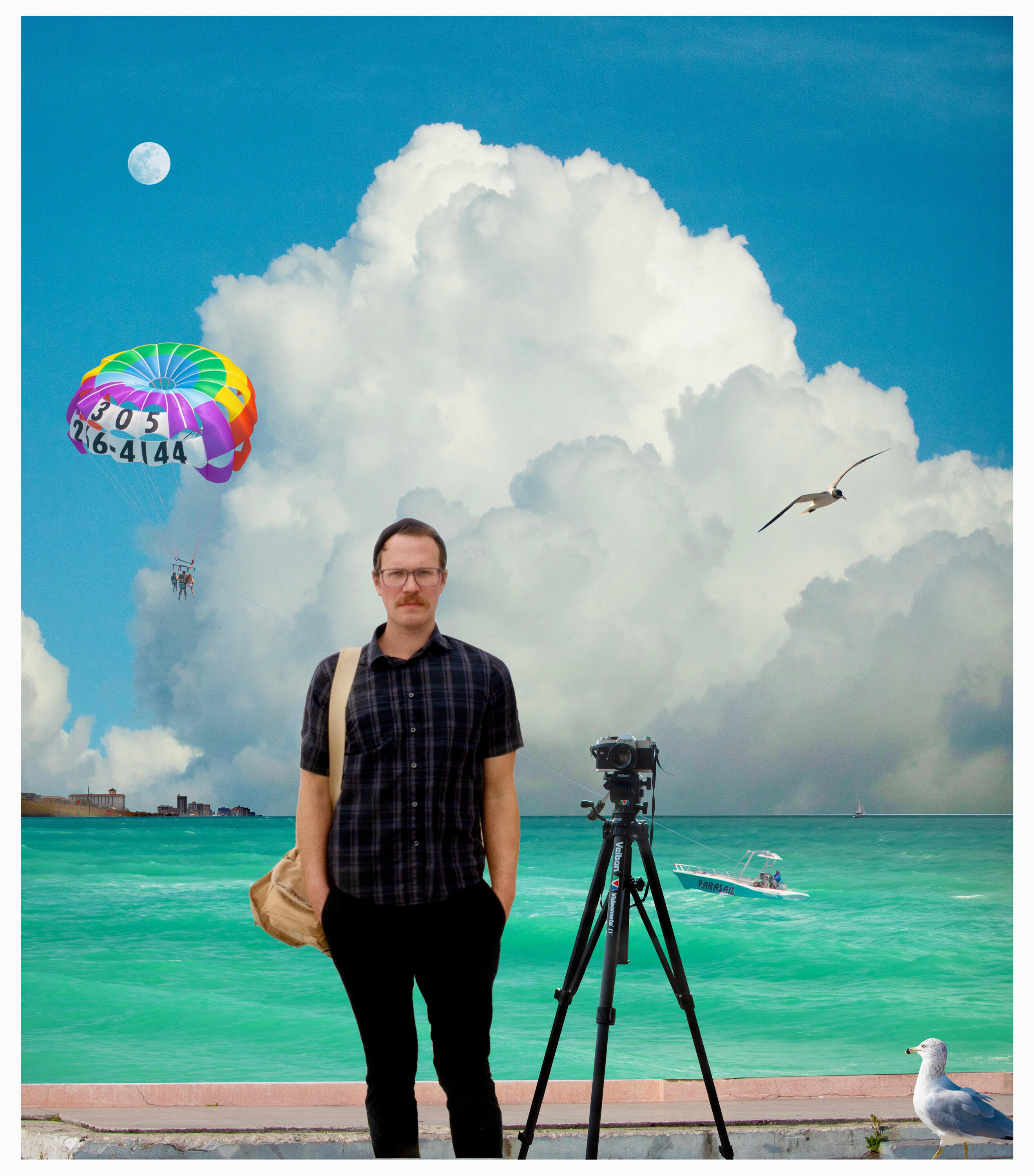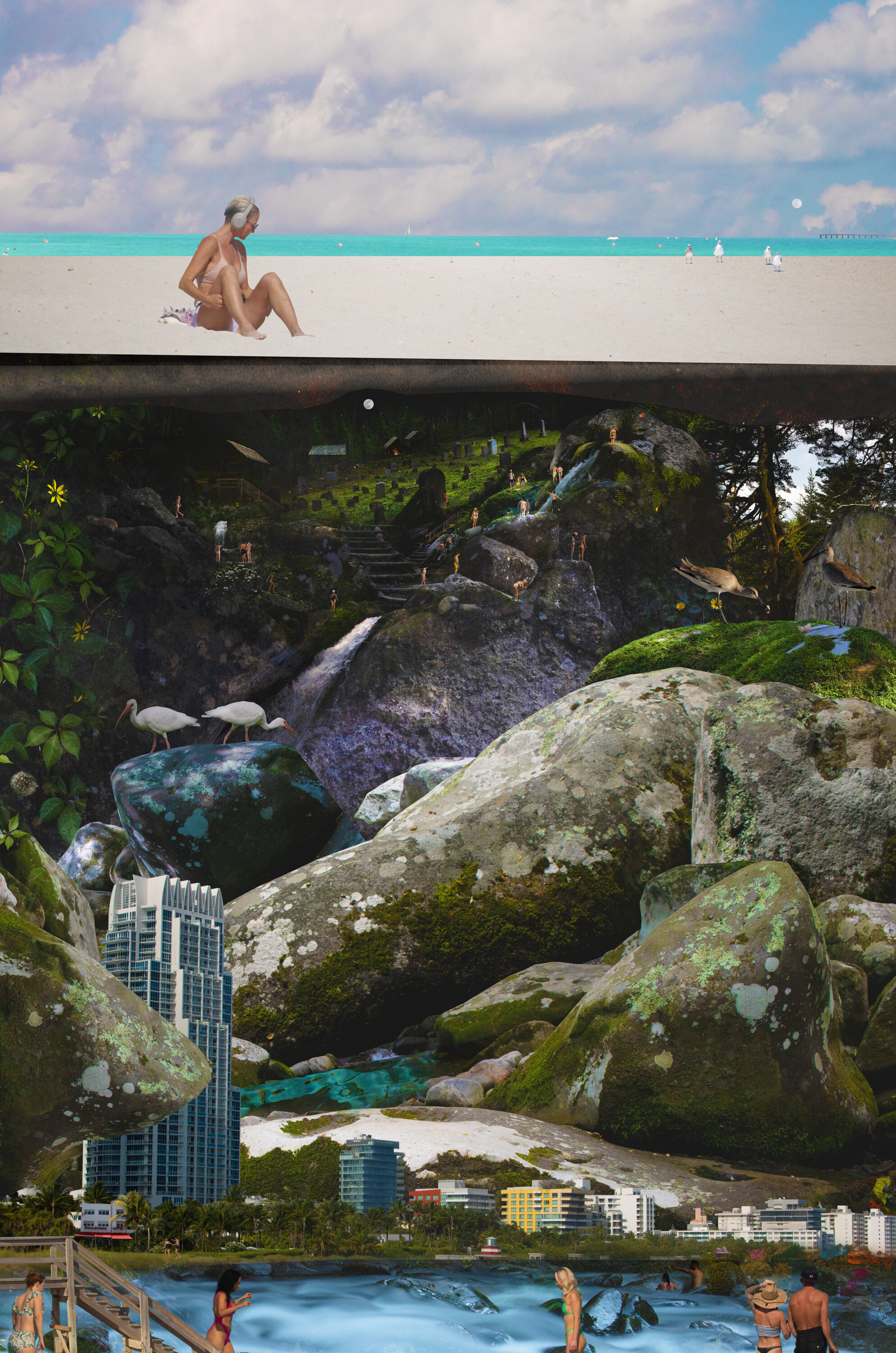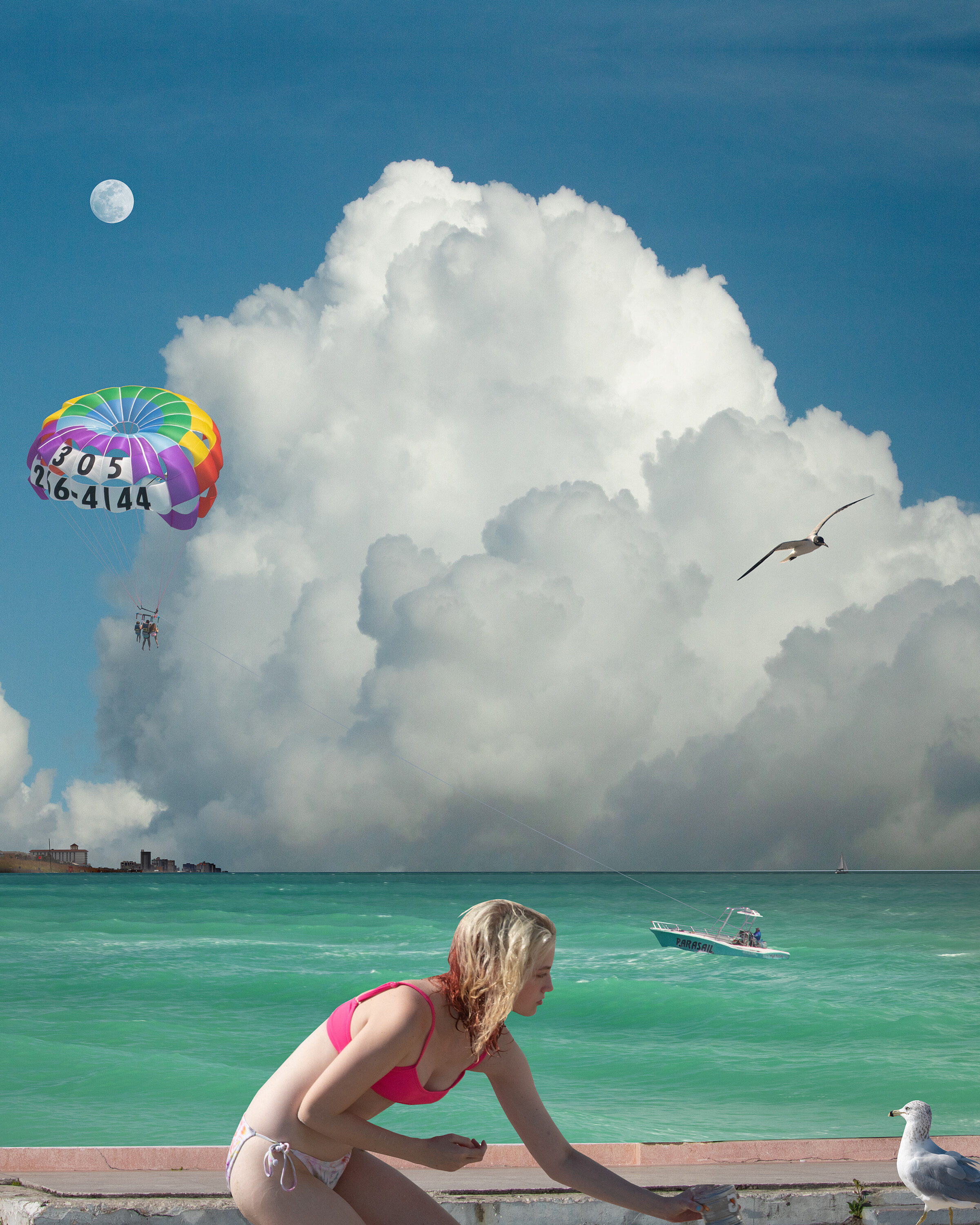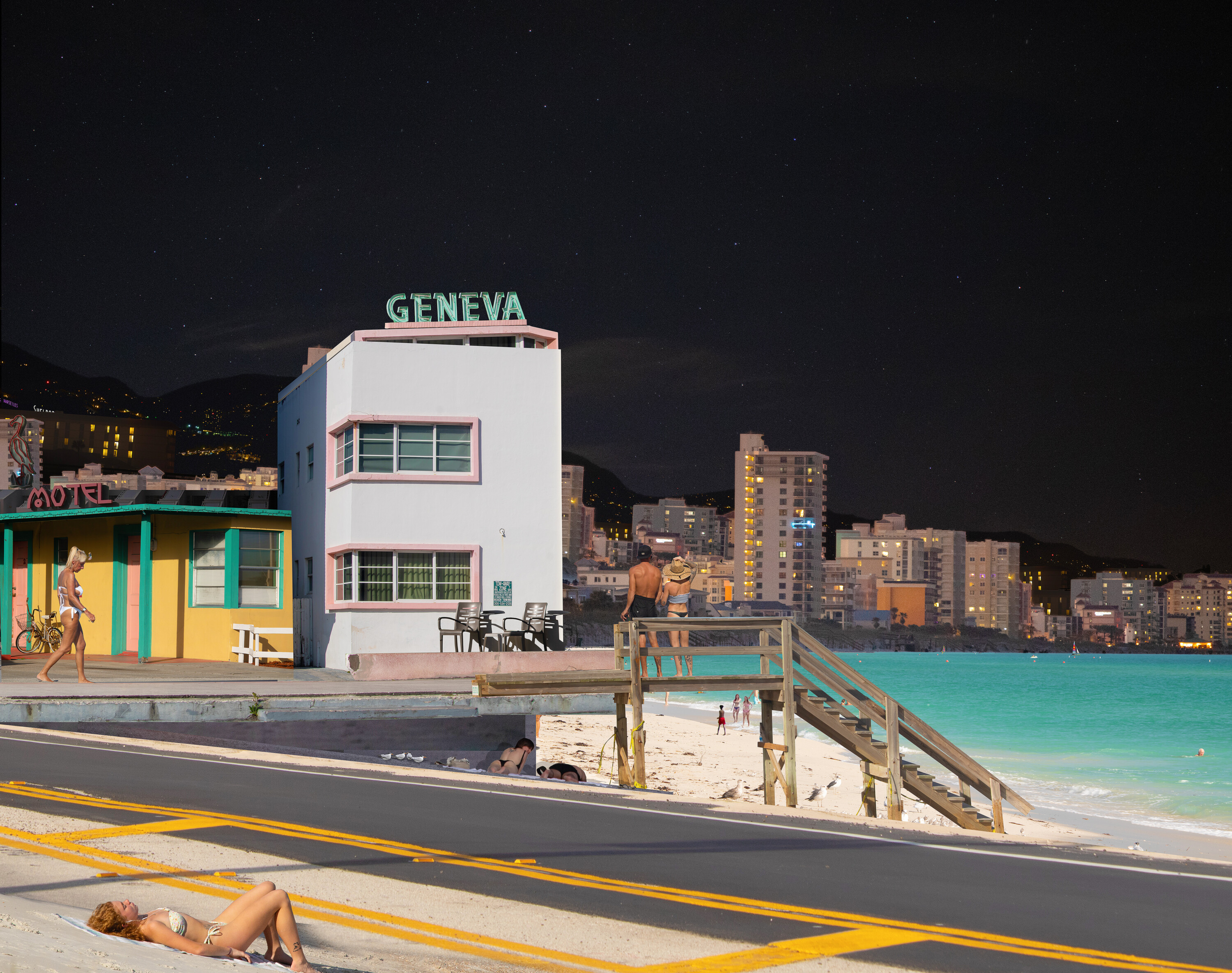Sound & Vision is a semi-regular feature that examines how music influences Northeast Florida artists. Accompanying playlists for each Sound & Vision feature can be found on JME’s spotify channel.
The future is ultimately resolute, carved into an unknowable stone. Regardless of our actions, desires, fears, or even the advent of providence and fate, if we are lucky to see it the future always meets us on its own terms.
Yet the past can appear sketched into the wet sand of a familiar shore. There are too many storytellers in our heads, clamoring to yell out the narrative. Memory moves through you and around you as it moves you further into time.
For the past decade-plus, artist Edison William has been creating images that are both haunting and humorous. He deals in ideas of the past colliding with the present, creating photographic collages that predict an ersatz future. Yet William isn’t a maudlin dystopian-obsessed artist. His work is injected with a humorous tone that makes it all the more invitational. His forthcoming show, Dreams of Real Places, is his most recent collection of counterfeit realities, born from his fascination with place, time, and where he stands within those two universal forces.
Along with working in traditional and newer visual arts media, William is also a musician and fan of music. For this installment of Sound & Vision, we asked William about the influence of both of these streams of art on his life and where they intersect.
Tell me about your upcoming show: Dreams of Real Places. How many pieces in total will be featured? Is there a collective theme that threads the images together?
Dreams of Real Places is a concept that explores a deeper understanding and connection to creating a romanticized version of the natural world. By deconstructing everyday objects (birds, clouds, oceans, moons, etc.) and re-presenting them within the realm of logic, I can manifest a kind of natural bridge to escapism with subconsciously palpable comprehension. I have grown to learn that I am most ambitious in trying to create a dramatic representation of “living theater” in nature, providing the eye with aesthetic enjoyment, portraying plants and animals and people through whimsicalities, with some general symbolisms, but mostly personal ones.
There are a total of nine large-scale prints in very ornate frames, seven of which are new, and a continuation of an idea I had in creating this world called Calypso. It a fictitious city in Florida that allows me to world build with greater ease, because I can create scenes of the same place, in different vantage points, but still showing similar perspectives. For example, Full Moon In Calypso (In Scorpio) is a scenario where the full moon is bright enough the bathe in, and the coastal skyline extends far down the bay. She Talks To The Gulls is a perspective that is great distance away, while Paradise Is Everywhere and Washed Ashore are daytime versions of being right within the world of Calypso. Egret in The Agave Fields, Scorpio Falls, and Summer Spring are high up in the mountains that tower behind the coastline. It is a way for me to breathe more life into the scene I’m creating, where I’ll say, “ok, well what is up in those mountains behind all those buildings?” They were the impetus for Calypso.

When I interviewed you 11 years ago for a solo show at Bold Bean in Riverside, you described your work as “photostration” and said that you “almost hate saying I’m a photographer.” You were 29 at the time. Do you still feel the same at age 40 and is that “photostration” style still apt?
Hey now, I’m still 39! Ha! But 40 is coming up quick. Yes, 11 years ago I was trying to get something across to the viewer, maybe even to myself. Basically, I thought photography was something incredibly easy to learn and create and produce imagery with, so I just felt the need to impress upon the viewer that these photographic representations are much more complicated in nature, and that my process yielded illustrative and painterly qualities, which is how and why I came up with “Photostrations.”
I honestly think I just wanted to impress painters. They work so hard for their craft, and I figured if I made my work more involved, I can separate myself further from traditional photographic practices, and appeal more to both crowds. It’s not a need for personal validation: I just always wanted to be recognized for adhering to the academic principles of photography, and intertwining it with painterly aspects with the elements of art (color, form, line, shape, texture, and value). I believe my work is much more convincing now, and I’m proud to call myself a photographic artist. I feel it’s beyond photography now.
“A part of me wants to do everything myself, and the other part of me despises that. I’m naturally a recluse, and it’s hard for me to reach out to people to see if they want to add something to my vision.”
For that aforementioned show, Chasing Nostalgia / Subconscious Assimilation, you were working with 35mm film and using slide projectors to create these kinds of layered images. Are you using the same type of media or do you also use digital cameras and software now?
I still use the same Canon digital camera I bought in 2014, with the same two lens. There’s sand imbedded in all the buttons, there’s dirt on the sensors, and both lenses are scratched. And I love it. Once I learned what my camera could do, I just stayed with it. I’m not materialistic, and I don’t need the newest and the best technology on the market. That and a basic subscription to Photoshop: I’ve been paying $9.99 a month for a decade. I probably should have just bought the damn software, but whatever. I’m not a whiz on it, but I’ve learned enough tricks to suit my practices, and that’s all I really need. I’m not opposed to getting the latest and greatest, and there may be a time when I just have to, but I’m very content being as technologically minimal as humanly possible.


In your present work, how laborious is your actual process in creating each image?
Laborious. That is absolutely one of the most draining and difficult aspects of my type of artistic interpretation. I cut out everything by drawing points around the subject. There are automatic ways to extract subjects in Photoshop, but they just aren’t very accurate and nowhere near as detailed as what I manually do. Some of my work contains almost 300 separate photographs, all taken by myself over the course of the last 10 years, and I’m still using parts of my photographs that are a decade old. Going through countless memory cards, loading, unloading, crashes and lost files…this is not fun. Not the most glamorous part of it all. Being on the beach at night, trying to capture lighting out to sea—that’s where I always want to be. But I have to push myself and dig deep in the mind to do everything I can to try and make the viewer feel connected to the places, just as much as I am. And I know how much I try to do so.
As the premise of the Sound & Vision column is essentially about the intersection of visual art and music, what are some of your favorite styles of music? Are there certain musicians, songs or pieces of music that inspire you to create?
I grew up in the British Invasion, and I was introduced to The Beatles at a very young age, which I am grateful for, but when I first started listening to The Kinks, I knew it suited me better. They were a little rougher around the edges, and [Ray Davies’] voice wasn’t the most aesthetically pleasing, so it gave me confidence because neither was mine; at all! I seemed to transition into Led Zeppelin when I was 17, and I was completely lost in them, then Pink Floyd got me into a type of mature psychedelia, and still to this day, just constantly living in the 1960s and 1970s. David Bowie, The Beach Boys, Velvet Underground, The Stooges, early Rolling Stones, obviously Jimi Hendrix, Bob Dylan, The Doors…these are the bands that shaped me. I grew fascinated with early Modest Mouse, went through a long love affair with Radiohead, then they bored me, and I found Animal Collective, and that band changed everything for me. I was immediately drawn to their song structure, and I definitely feel like those influences along with everything prior allowed me to start composing music myself. As far as creating imagery on the computer, I just can’t listen to music. It’s distracting, really. I’ll listen to Echoes of Nature, sounds of storms and waves and rivers and frog choruses, which really set the mood for the worlds I make. If it’s meticulous work that take a long time, I’ll listen to the old 1940s radio broadcasts of Sherlock Holmes, something I can hear and ignore at the same time. When I’m out shooting, I listen to everything going around me, so that I can really immerse myself in the space I’m capturing. I’m a big people-watcher, and I study and analyze behaviors and dynamics of families, birds and just the constant movements within each ecosystem.
You’re a musician as well as a visual artist. Did one vocation precede the other? Or did you start creating music and visual art at the same time in your life?
I started taking a photography course at the University of North Florida in 2005; long before I started writing music. I started teaching myself piano and guitar in 2009, a very late start, which I’m still kind of upset about. Sometimes you just don’t find yourself until later in life, and for me it was in my late twenties, early thirties. Better late than never, I suppose. But I feel really good about how I’m progressing and getting myself set up for a very fruitful forties.
Do you feel like your visual arts practice informs your music, or vice versa?
I think my visual and musical interpretations have some similarities; in that they are both share a bizarre, sometimes eccentric style of storytelling. My music is sometimes a bit bombastic, especially the little previews that I share online. But the more mature pieces, where I’m much calmer and I take my voice much lower and spend a lot of time constructing the lyrics. That character is “Arizona,” and I haven’t shared it yet because that will be my project that I actually release. Once I put something out that I consider to be a mature evaluation of the mysterious side of myself, then I can be silly and loud and bombastic again. Then mature and then let loose.
Like many Floridians, you aren’t a native to the state, but since you moved here when you were a child, you have had a direct experience in seeing it develop (or degrade) in all of its gore and grandeur. If I view your work in total, my read is a kind of nostalgia; even a haunted aspect. Do you feel like there is a type of longing or wistfulness in your images?
I can agree with that wholeheartedly. There’s something in the way my mind operates, in the way it processes my own surroundings. I grew up with a lot of sadness and the beautiful parts of life mean so much to me. But I can’t seem to be fully “happy.” So, I’m inclined to romanticize melancholy. It was a conflict of interest I had with my relationship with Florida in general. I’ve spent almost all of my adult life moving to Riverside, abruptly moving to New York, moving back to Avondale, then hastily moving to Philadelphia, then Chicago for a bit, then finally back to the beaches. My point is, I tried to move away so much because I felt something was missing in my life here in Jacksonville. The people here, the artists, the musicians, are beautiful souls and I’ve made lifelong friends with so many. The problem was me. I felt nervous that I wasn’t worldly enough, that I wasn’t fully submersed in the active flow of life, and that I wasn’t going to meet my own expectations of my fullest potential in art.
Then it clicked: when I live near the ocean, I am my best. When I stay in my bubble, I stay out of trouble. So, I can’t see myself living anywhere else for the time being. But I have to be at the beach. It is my strongest connection to the best version of my own nostalgia. I can create worlds in my own timeline, without any influence except my own crawling pace of invention. And I swim in the ocean, watch out for sharks and then lay in the hot sand and watch planes fly north, up above. It was always Atlantic Beach for me. I still go to the mountains all the time—I’m fact I’m up here right now, writing to you. If I just stay in the bubble a little while longer, I know I can meet my objectives. I’m finally in love with the city I always thought I needed to leave. It’s a wonderful feeling, and it took a long time to get here.
You told me you are creating a fictitious city in Florida called “Calypso.” What inspired you to attempt this imaginary city-planning and how big have you gone with the actual idea of this place? Can you describe what the city is like as far as population, demographics, landmarks or cultural offerings?
The idea of creating a world for myself came to me a few years ago, when I realized I needed a place to really escape to. It’s similar to world-generation in video games, albeit just on the surface level. I honestly just thought it was a natural progression of mapping out a place that seemed familiar and fantastic, and as I spent years obtaining imagery from generally two distinct places: Atlantic Beach and the Great Smoky Mountains. I decided to just branch out on already existing ideas and further develop it; just as I am developing. I would say I’m just starting on Calypso. It’s a gorgeous little coastal town, with several bays, emerald green waters, wicked storms, glamorous as well as slummy, introspective birds, drunks, beach bums and very tourist friendly. The mountains that rise behind the coastline are contain lush tropical forests, with natural springs and waterfalls into pools, and fields of agave for this tequila-minded town. The moon shines brighter here, rivaling daylight at its fullest. I’m developing bars, restaurants, art galleries with cliché beach art; even the interiors of some of the condos on the shore. The population varies greatly from season to season and I’m working towards developing the specifics of showing the beauty and the fallacies of city planning. The best and the worst of it all, just like my own. But I always want to live in Calypso. That’s what makes it so entertaining to me.

Since the advent of LPs, album art has been as iconoclastic and influential as actual music. Have certain album covers or album cover designers influenced your own work or views toward visual art?
I love collage, specifically magazine cutouts pieced back together. Pair that with vibrant colors and that’s what I’ll always be drawn to. I would say that Storm Thorgerson has inspired me the most, not just what he’s done with Pink Floyd, but he’s actually worked on so many album covers: Led Zeppelin, Supertramp, ELO, T. Rex, etc. the man is a genius. Those images he created helped define the mood you feel when you listen to the music. He was so profoundly prolific with his creative abilities. I’ve made some really interesting album covers for myself because of his influence. I’m excited to share that.
Singer-songwriter Dessi Lopez is performing live music at the opening to your show. How did you connect with them and why did you choose them in particular to perform at the reception?
Dessi is an extremely talented musician. What a beautiful voice and just an absolute gem of a person. She’s been very supportive of me and my craft over the years as I have been with hers. It’s natural for two people who admire each other’s craft to work together in harmony; especially with different types of expression. If some people get confused by my work and don’t know how to feel, Dessi will be the beacon in the night, creating a beautiful vision that fits right at home by the beach. We also share the same love and passion for Atlantic Beach.
Tell me about the songs you picked to compile your Sound & Vision playlist: Are there older favorite songs included or are some of these songs that you more recently discovered?
All of the songs I’ve complied are ones that spoke deeply to me over the years. I tried and failed singing “Ashes to Ashes” at karaoke, for example, but it means so much to me, so I just had to try. These songs just make me feel something intangible, something visceral and specific to myself. It’s everyone’s music but these particular ones have at one point, or still do, inspire me—by the very definition. Amen Dunes is a fantastic artist, but “Dracula” is a mood that I want to swim in. It’s all about moods for me, same with Kurt Vile and The Magnetic Fields…mood generators.
The opening reception for Dreams of Real Places is held from 5-9 p.m. on Thursday, June 15 at T-Dub’s Mercantile in Atlantic Beach. The event coincides with North Beaches Artwalk and features live music from Dessi Lopez. The exhibit is on display through June 26. You can view more of Edison William’s work @edisonwilliam.

Song of the Day | “Empty Trainload of Sky” by Gillian Welch and David Rawlings

The Neighborhood Playlist | July 20

Jax Music Hour Playlist | July 20

UK Shoegazers Slowdive to Kick Off New Fall Tour at St. Augustine Amphitheatre

Flipturn, St. Paul & the Broken Bones Highlight this Year’s Two-Day Florida Fest in Jacksonville Beach

Song of the Day | “Coast” by Kim Deal

The Latest Collab from Dillon and Batsauce Serves Up High Quality Production with Kindred Spirit Kool Keith

Song of the Day | “Lie 95” by Bartees Strange

Newly-Released Archive Recordings of Neil Young & Crazy Horse, ‘Early Daze’ is a Crucial Document of the Group’s Prime Era
